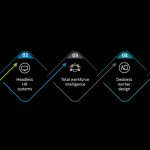
Authored by Franz Gilbert, Matthew Shannon, and Erin Spencer
Deloitte’s Human Capital Forward team predicts how five of today’s HR technology trends could innovate across disparate systems, work processes, and workforce experiences in 2024.
Technology never fails to innovate. Across the last year, human resources (HR) leaders were inundated with responding to new trends and challenges, including implications of advanced analytics and artificial intelligence. To help prepare for another year of trends and changes in the HR technology market, Deloitte’s Human Capital Forward team, which focuses on relationship building with and insights about HR technology providers, forecasts their predictions on overarching influences for the year ahead.
Below are five evidence-backed predictions on why the topic will innovate further in 2024 and how HR leaders can begin preparing for the future of HR technology today .
Prediction 1: Generative AI focus will shift from spot use cases to ubiquity across solution sets.
Predictions on HR technology innovations and trends would be remiss not to start with the implications of a technology that could generate 10% of all data by 2025.1 Generative AI is artificial intelligence (AI) that creates original content across various modalities (for example, text, images, audio, code, video, 3D/specialized models) that previously required human skill and expertise to create. It can help businesses improve their products and services, automate repetitive tasks, and create innovative customer experiences.2 HR technology, a longtime user of AI and machine learning functionality, was quick to integrate generative AI capabilities into existing solution sets, allowing for targeted purposes—such as text-based content generation (for example, candidate interaction e-mails), large volume data summarization (for example, synthesizing feedback on performance), and insights surfacing (for example, querying HR policy to answer worker questions).
We expect that in 2024, Generative AI will be even further integrated with existing HR technology solutions sets and have the ability to exchange information directly with point solutions. HR technology customers and users will likely encounter Generative AI not only in specific use cases but embedded in their existing technology solutions (for example, email platforms, word processors, and team communication tools), designed from the ground up in innovative startup solutions (for example, voice agents) and through middleware solutions that connect systems of engagement with systems of record. Understanding where to use Generative AI capabilities contributes to the piecemeal usage of the technology today. Across the next year, workers will encounter the capabilities more regularly, enabling a more natural fit of Generative AI into daily workflows.
While still a nascent technology in workplace applications, Generative AI will likely transition from a use case feature in HR tech to a fundamental enabler with integrated functionality ranging from supporting implementations to translating code/data sources (for example, skills).3 As large human capital management (HCM) system players are likely to open their marketplaces to encourage innovation at the edge, HR leaders will need to remain aware and consider additive solutions that meet their shifting requirements. Users should also embrace the concepts of responsible AI and explainable AI as critical capabilities for countering effects of negative bias. Familiarizing the workforce with current capabilities will help spark questions that drive future innovations.
Prediction 2: Headless HR systems will allow workers to access HR technology from desired interfaces.
A headless HR system refers to any HR process platform or point solution that operates without requiring the use of a traditional user interface or front end. The back-end functionality of the HR system is decoupled from the presentation layer, allowing for more flexibility and customization in how the system is used and integrated with other applications. Features are connected through application programming interfaces (APIs) and can be integrated into various platforms, applications, or interfaces without being tied to a specific front-end design.
We expect that in 2024, the trend will experience a critical mass, enabling headless HR systems to feel uniform. No longer competing to be the “system of engagement,” an increasing number of point solution providers (for example, skills solutions) will recognize the value their solutions have in serving as a middleware between other incumbent technology (for example, HCM, applicant tracking system, learning management system). This is a crucial step in moving toward a modern HR technology stack where various tools already embrace the requirement for inter-solution compatibility and APIs.
Even if headless HR systems don’t have a centralized system for all user experiences, HR technology infrastructure needs to be orchestrated for well-managed consumer experiences.5 The shift toward headless HR systems is enabled by greater integration, flexibility, and adaptability of solutions but also driven by the need to meet workers in their preferred platform of engagement. As organizations seek to deliver this type of efficient and personalized HR user experience, the interoperability of the HR technology stack will be a focal point.
Prediction 3: Total workforce intelligence will enable more strategic and efficient use of contingent labor.
The next year will welcome changes to how content is generated and systems are integrated, but it will also see innovation in the way workforce data is accessed and analyzed. Total workforce intelligence (TWI) is a consolidated approach that helps organizations manage their workforces by utilizing external labor market data across talent models. TWI analyzes job postings, résumés, talent profiles, and census data to gain insights into skills and talent availability. Leveraging this data enables informed decisions on workforce planning, hiring, and training, enhancing productivity and agility. Ongoing TWI development provides a clearer talent landscape view, improving workforce planning and nontraditional labor sourcing opportunities.
TWI is gaining traction as organizations adapt to the evolving labor landscape. Recent workforce changes show a shift toward non-full-time employment arrangements, with 55% of workers open to such arrangements. Contingent working arrangements have increased, with a rise in spend under management. In the United States, contingent labor pools make up more than a third of the labor market.8 In 2024, HR teams will improve management of the contingent worker experience, driven by the need for greater visibility between full-time and contingent workforces. The European Union’s new Corporate Sustainability Reporting Directive will require transparent reporting of workforce composition.9 This comprehensive approach, incorporating TWI programs, streamlines contingent workforce management and facilitates strategic workforce planning by blending labor market insights with organizational data, allowing organizations to navigate the volatile market landscape efficiently.
Transitioning to a TWI approach for seamless job posting requires caution due to market readiness. This shift emphasizes the importance of organizations navigating the evolving talent landscape carefully. TWI is essential for managing a unified and productive workforce,10 especially with the growing significance of the contingent workforce. Embracing the concept positions organizations to navigate business challenges and opportunities, empowering their workforces to drive innovation, productivity, and competitive advantage.
Prediction 4: Deskless worker design focus will further enable front-line digital workplaces.
HR technology has long strived to meet workers where they are but has not always met the needs of workers spending their days away from a desk or monitor. Deskless worker design envisions an HR tech-driven future for front-line workers in industries such as retail, health care, and manufacturing. This approach empowers deskless workers through technology, enhancing their work experience, increasing business success, and fostering a positive workplace culture. Designed for smartphones and tablets, deskless worker design fills a significant experience gap and enables a more productive and connected workforce.11
Many HR technology providers have redesigned or rebranded their products to focus on the worker experience. Transitioning from desktop to mobile platforms reflects the influence of mobile technology and the growing emphasis on the front-line workforce. Deskless worker design features mobile-friendly platforms for seamless access to work information and collaboration tools from any location.12 In 2024, we anticipate increased focus on deskless workforce engagement and addressing attrition risk. HR technology tailored for deskless industries promotes a safe and secure work environment.11 Investing in the digital experience improves productivity and retention for deskless workers. Rectifying historical oversights in enterprise software spending presents an opportunity to equip essential workers with improved tools and technologies.
In the ever-evolving landscape of workforce dynamics, harnessing technology becomes paramount in engaging deskless workers. This strategic shift involves not only optimizing HR processes through the adoption of deskless systems but also leveraging innovative tools to enhance overall workforce experience. Organizations can optimize HR, foster collaboration, and manage the engagement and retention of their deskless workforce through these tech-driven approaches. With most of the global workforce being deskless workers,12 the time has come to stop overlooking their experiences with HR technology.
Prediction 5: Digital identity management will become a new hiring requirement.
Digital identity management is the process of managing and authenticating the identities of individuals, devices, or entities in a digital environment. Digital identity management is particularly important in the context of cybersecurity and protecting against identity theft, unauthorized access, and other digital security threats.13 It plays a crucial role in attempting to safeguard sensitive information and works toward ensuring that only authorized individuals or entities have access to specific resources or services.
As more aspects of our lives move online, from banking and shopping to communication and health care, the need for reliable and secure digital identities becomes crucial.14 In 2024, we expect to see digital identity management play a strong role in authenticating and verifying individuals as an employment requirement. Advances in AI and machine learning contribute to the development of more sophisticated identity verification and fraud detection systems, helping to make digital identity management more robust and effective. Digital identity management will help organizations comply with stricter data protection and privacy regulations implemented by governments and regulatory bodies by working toward secure handling and storage of personal information.15 Demands for user convenience can streamline and simplify user experiences by reducing the need for multiple usernames and passwords.
As more organizations adopt digital identity management solutions, HR leaders should be proactive in preparing for the impact of these technologies on the workforce. Overall, the increasing complexity and interconnectedness of the digital landscape, combined with the need for enhanced security and privacy, are driving the prevalence of digital identity management in the future.
For a deeper look at each of these predictions, explore the collection in Deloitte’s Insights2Action platform.
Source: www2.deloitte.com









